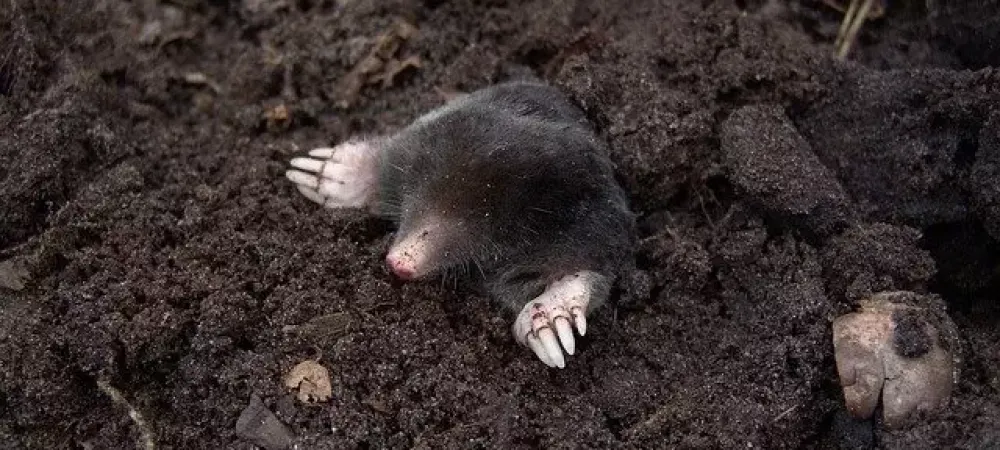How to Identify and Get Rid of Moles

Few animals can destroy your property as quickly as moles. With their pointed muzzles, large front feet, and huge appetites, moles pose a major threat to your landscaping AND your wallet. In fact, these destructive critters cost Washington homeowners thousands of dollars in repairs per year and in many cases significantly reduce property value. As a Washington resident, the more you know about moles, the better off you’ll be. Luckily, you can learn everything you need to know about them right here!
What Are Moles?
If you imagine them as small, rodent-like animals, then you’re on the right track. Moles do indeed share many physical similarities with rats including their pointed snout, small eyes, and dark brown or gray fur. Other defining characteristics include their lack of external ears and their large digging claws that allow them to move quickly through soil.
Interestingly moles are not rodents but a different order of mammal called Soricomorpha which eats primarily insects. Their diet generally consists of earthworms, grubs, and other insects or larvae found underground. Damage to your lawn and plants usually comes as a result of tunneling through your soil in search of these insects, not as a result of moles directly eating your plant roots.
Types of Moles
Not all moles are the same when it comes to appearance and diet, however. In fact, there are many different species including the star-nosed mole, hairy-tailed mole, golden mole, and more! The three most common moles in Washington are the Townsend’s Mole, the Pacific Mole or Coast Mole, and the Shrew Mole which can be identified as follows:
- Townsend’s moles lack distinctive qualities aside from their above-average size with some measuring over 9 inches. Unlike other species which damage plants in their quest for insects, Townsend’s moles actually feed on bulbs and seeds on occasion.
- Pacific moles look nearly identical to Townsend’s moles but generally measure less than 7 inches in length.
- Shrew moles are only four to five inches long and lack the large front feet of other species. Shrews are less destructive than moles and, in many instances, can exist in a garden without harming plants.
Moles vs. Voles
It can also be helpful to know the difference between moles and voles since voles come with their own unique set of problems. Voles actually are rodents and will gnaw on the roots, leaves, and stems of your trees and shrubs. As for their physical appearance, voles have visible eyes and ears and a slightly more rounded snout. If you're dealing with voles, a different set of solutions will apply which is why being able to identify both types of pests is important.
Signs of Moles in Your Yard
Moles may live underground, but that doesn’t mean they’re impossible to find. In fact, there are several tell-tale signs that you have a mole infestation.
Common signs include:
- Raised ridges of soil that indicate surface tunnels
- Molehills (volcano-shaped mounds of dirt)
- Areas of soil that feel spongy or loose
- Dead grass or brown patches
- Dead or damaged ornamentals
These indicators of mole activity are your sign that it’s time to take action before the damage to your plants worsens.
What Attracts Moles?
The best way to prevent moles from making themselves at home in your yard is to make your property as uninviting as possible. If the following conditions describe your lawn, you may be at risk of a serious infestation:
- A lawn with a large population of grubs and insects: By eliminating their food sources through grub control and other pest treatments, moles will need to move on from your yard in search of a food source.
- A particularly soft, moist, and shady lawn: Avoid overwatering your lawn and aim to maintain a slightly drier property to prevent them from easily tunneling and building their homes in your yard.
- Properties lacking natural mole repellents: Because plants like daffodils, marigolds, and castor beans serve as natural repellents, their presence can make a yard less inviting to the animals.
How to Deal with a Mole Infestation
Getting rid of moles is a big job. Although there are natural remedies to prevent infestations as well as store-bought treatments, the safest and most effective way to get rid of moles completely is to contact a professional pest control company. At Sound Pest Control, we have the solutions needed to eliminate them before they cause serious damage to your lawn and plants. You can trust our eco-friendly mole control to protect your lawn from infestation AND from harmful chemicals.
